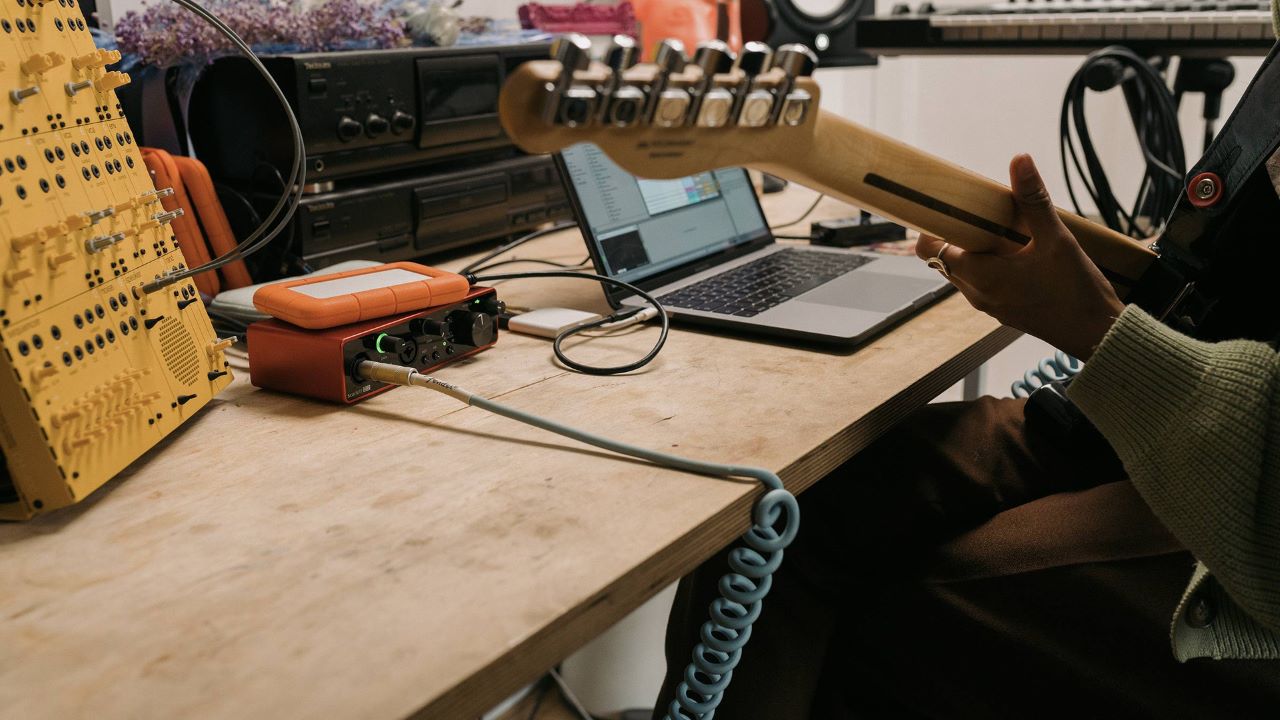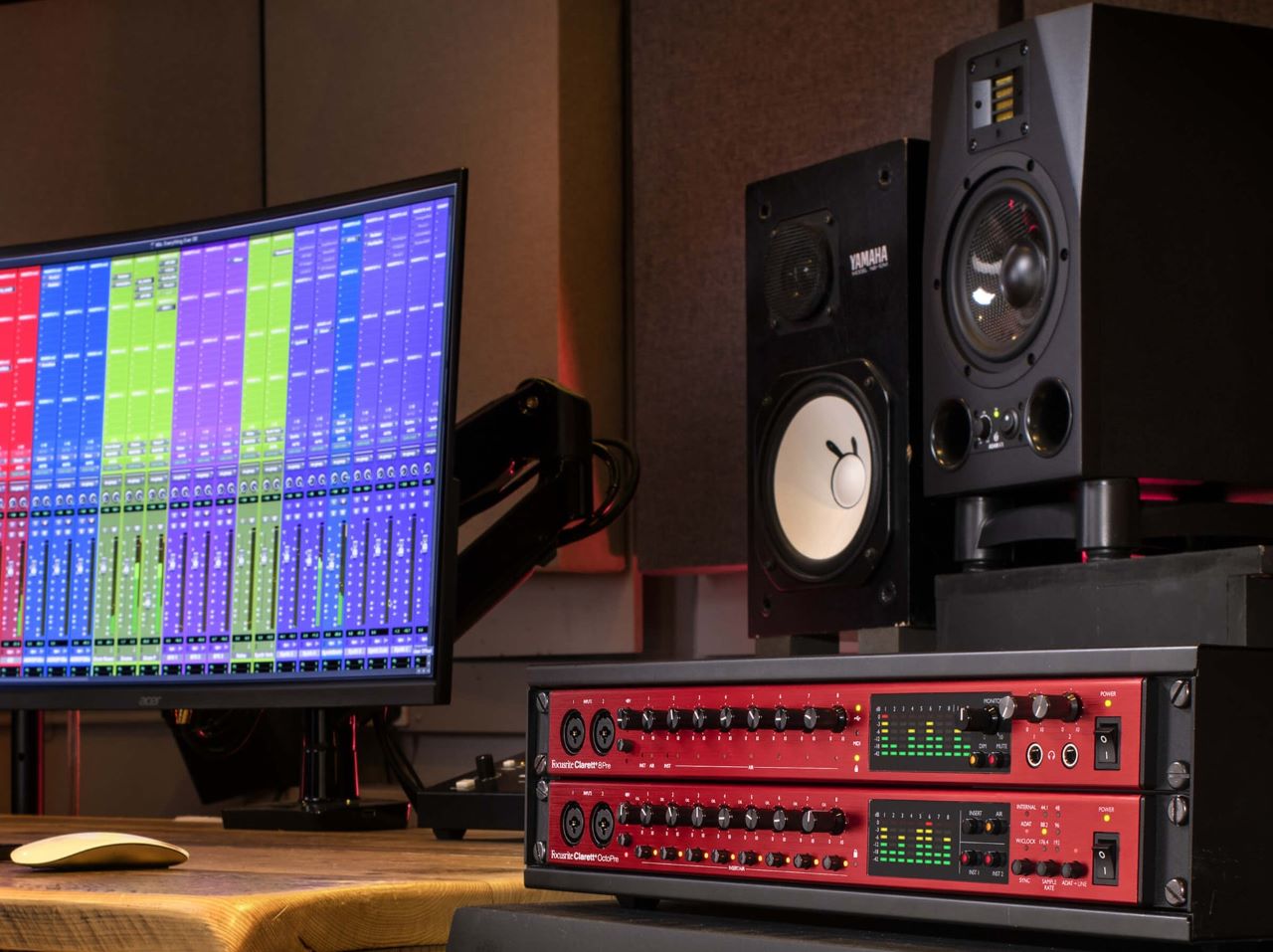Welcome to the universe of professional audio interfaces! If you’re reading this, chances are you’re either a budding audiophile, a seasoned musician, or somewhere in between, and you’re on the quest to find the most efficient interface for your studio. As you might have noticed, the world of audio gear is vast, with options galore, and while choices are good, they can sometimes be overwhelming.
Focusrite, a leader in the audio interface industry, has offered two compelling series to users worldwide: Clarett and Scarlett. But how do you pick one over the other? This isn’t just about aesthetics or brand loyalty; it’s about understanding the nuances, comparing technical capabilities, and assessing the value.
This article on Focusrite Clarett vs Scarlett aims to provide a comprehensive comparison between these two titans. Whether you’re setting up your first home studio or looking to upgrade, we’ve got you covered. Let’s embark on this journey to discover which one truly resonates with your needs.
Related: Top 9 Best Podcast Mixers
Contents
Historical Background Of Focusrite’s Interfaces
There’s nothing like a bit of history to understand why and how certain products were made. And with Focusrite, there’s a story to tell.
Focusrite’s Evolution in Audio Interface Market
Way back when Focusrite wasn’t as big a name as it is today. Starting from humble beginnings in the mid-1980s, they rose to prominence in the professional audio world. Their initial forte? Outboard gear and console designs that turned heads and ears. Soon enough, they decided to make a splash in the audio interface market.
Today, when you talk audio interfaces, Focusrite is one of the first names that pop up. But how did they etch this position in stone?
Birth of the Scarlett Series

Focusrite Scarlett audio interfaces have enabled musicians, songwriters, and producers worldwide to record, mix and playback audio. Image Source.
Enter Scarlett: A revolution in affordable, high-quality audio interfaces for the masses. When Scarlett was introduced, it was like a breath of fresh air. Aimed at everyone from budding musicians to semi-pros, it blended great audio quality with a price point that didn’t require taking out a second mortgage.
It wasn’t just about affordability. Scarlett brought in robust build quality, ease of use, and a striking red aesthetic that became instantly recognizable in studios worldwide.
Introduction of the Clarett Series
Then came Clarett, Focusrite’s answer to the evolving needs of the professional audio world. Packed with features, this series addressed every tiny hiccup users found with the Scarlett models. Boasting better preamps, lower latency, and advanced Thunderbolt connectivity, Clarett was poised to become a mainstay in higher-end studios. The Clarett audio interface options were specifically crafted to meet a broad spectrum of needs.
Focusrite Clarett vs Scarlett [Core Technical Differences]
Now, for the part you’ve been waiting for, The face-off. Let’s talk tech.
Preamps And Sound Quality
The heart and soul of any audio interface lie in its preamps and the overall sound quality it delivers. This is where the magic happens: transforming your vocal or instrument into a digital signal that a computer can understand. If you were comparing the microphone inputs on these devices, for instance, you’d find differences that could influence your buying decision. The better the preamp, the clearer and more authentic this transformation is. When comparing Scarlett and Clarett, we’re essentially looking at two titans clashing. Let’s explore how they stack up.
Scarlett’s Preamps
The Scarlett series is no slouch in the preamp department. These interfaces offer:
- High headroom.
- Crystal clear sound capture.
- Minimal noise, especially in the 2nd and 3rd gen models.
But what really makes them shine?
- Their features and quality: Scarlett preamps are designed for versatility. Whether you’re recording vocals, guitars, or synthesizers, they ensure consistent clarity.
- Durability: These preamps are built to last, ideal for regular and rigorous use.
Clarett’s Air-enabled Preamps
Now, the Clarett series takes things up a notch.
- How they simulate the classic ISA preamp: By activating the “Air” mode, these preamps can emulate Focusrite’s classic ISA preamp coloration, giving your recordings a touch of vintage warmth.
- Benefits in sound quality and recording clarity: With the Clarett, you get cleaner highs, more pronounced mids, and a tighter low end. This distinction becomes palpable, especially in professional settings.
Connectivity and Latency

Clarett+ OctoPre adds eight channels of digital expandability to 2Pre, 4Pre or 8Pre. Image Source.
The world of audio interfaces isn’t just about sound. It’s about how swiftly and efficiently you can get that sound into your computer without delay or latency. The type of connection your interface uses can play a massive role in this process. Both speed and compatibility are key.
With Scarlett and Clarett offering different connectivity options, understanding their implications can guide you to a smoother recording experience. For example, while Scarlett offers a reliable headphone output, Clarett is renowned for its quick data transmission. Dive in!
Scarlett’s USB Connectivity
USB has been the go-to for many, primarily because of its ubiquity. Scarlett’s offerings are:
- Speedy data transmission.
- Broad compatibility with both PCs and Macs.
- Reliable performance, especially with the USB-C models in the latest generation.
Clarett’s Thunderbolt Connectivity
Thunderbolt, though, is where Clarett plays its trump card.
- Advantages of Thunderbolt: It’s all about speed and reduced latency. This means you can run more plugins in real time without any perceivable delay.
- Comparison in real-world recording scenarios: When you’re recording multiple tracks simultaneously or stacking up those VSTs, Clarett’s edge becomes evident. Less latency means more immediate feedback and a smoother recording process.
Related: Best Thunderbolt Audio Interface For Logic Pro X
Conversion And Sample Rates
Both series pride themselves on high-quality ADC and DAC. But what does that mean for you? The better conversion ensures that the sound captured is as close to the original as possible. Moreover, with higher maximum sample rates, you get better audio resolution. For the average user, both will more than suffice. For the pros, Clarett’s slight edge might be the deciding factor.
Design And Build Quality
First impressions count. The design of an audio interface isn’t just about aesthetics; it speaks volumes about the brand’s philosophy. But beyond the looks, there’s the question of durability and functionality. A great interface should not only look good but also withstand the test of time, especially if you’re constantly on the move. Let’s inspect the exteriors and build of both series.
Physical Appearance
At first glance, Scarlett’s fiery red chassis catches the eye. It’s bold and vibrant. Clarett, on the other hand, opts for a more subdued, professional look with its sleek aluminum finish. The choice here is more aesthetic than functional, but hey, who said you can’t have a stylish studio?
Build Material and Durability
Scarlett is sturdy. Made primarily of metal with some plastic components, it’s built for longevity. Clarett, with its all-metal chassis, feels a tad more premium and is equally durable.
Front and Rear Panel Layouts
Both series offer a plethora of inputs and outputs. Focusrite Scarlett tends to be more straightforward, great for those just getting their feet wet. Clarett offers more granularity in controls, catering to the pros who need that precision.
Software Bundles And Compatibility
An audio interface is as good as the software it comes with and supports. It’s like buying a high-end gaming console; the hardware might be top-notch, but if the games (software) aren’t there, you’re not unlocking its full potential. With both Clarett and Scarlett offering a suite of software, it’s essential to see what adds more value to your recording journey.
Scarlett Software Bundle
With Scarlett, you get:
- A decent DAW in the form of Ableton Live Lite.
- A collection of plugins and effects.
- Loops and samples to kickstart your production journey.
Clarett Software Bundle
Clarett steps it up with the following:
- Additional plugins from renowned manufacturers.
- A more extensive sample library.
- Sometimes, even a full-fledged DAW thrown into the mix.
OS and DAW Compatibility
Both series support the major OS out there: Windows and macOS. As for DAW compatibility, whether you’re on Ableton, Pro Tools, FL Studio, or Logic, both Scarlett and Clarett have got you covered.
Price And Value Proposition
Here’s the real meat of the matter. In the world of audio gear, the price can range from “That’s it?” to “Wait, how many zeros?!” But price alone can be deceptive. It’s the value proposition – what you’re getting for that price – that truly matters. As we compare Scarlett and Clarett’s price points, we’ll also shed light on their overall value, ensuring you get the most bang for your buck.
Price Comparison
Scarlett generally leans on the more affordable side, making it a favorite among beginners and hobbyists. Clarett, given its advanced features, commands a higher price.
Determining Value for Money
Value isn’t just about price. It’s about what you get for that price. While Scarlett offers fantastic value for those starting out, Clarett provides a compelling package for seasoned professionals seeking top-tier performance.
Focusrite Clarett vs Scarlett [Which Is Right For You?]
Not all audio interfaces cater to the same crowd. Just like a jackhammer isn’t the right tool for a chisel’s job, an interface tailored for a professional recording studio might be overkill for a hobbyist. Depending on your specific needs – be it podcasting, touring, or just starting with your bedroom studio – one series might be more suitable than the other. Let’s help you find the perfect fit.
Home Studios and Beginners
Scarlett is a no-brainer here. Its blend of quality, ease of use, and affordability make it perfect for those just starting out.
Professional Studios and Touring Musicians
Clarett, with its advanced features, is more in tune with the needs of pros. Lower latency, better preamps, and Thunderbolt connectivity give it the edge.
Podcasters and Streamers
Either could work, but Scarlett, with its straightforward approach, might be more apt for this audience. However, if you’re looking for the best sound quality for your listeners, Clarett might be worth the investment.
FAQs
Does Clarett Sound Better Than Scarlett?
Both the Clarett and Scarlett interfaces offer stellar sound quality, given their respective market segments. But if we delve into the specifics, there are some distinctions:
- Preamps: Clarett boasts ‘Air’ mode, which emulates the classic Focusrite ISA preamp sound, providing a brighter and more open sound. This gives Clarett an edge in sound clarity and depth, especially for vocals and acoustic instruments.
- Dynamic Range: Clarett interfaces generally have a slightly higher dynamic range compared to Scarlett, leading to clearer recordings with less noise.
- Sample Rates and Conversion: Both series offer up to 192kHz, but Clarett’s converters have been lauded for slightly better precision, which can make a difference in professional setups.
However, for many users, especially beginners or those using the interface in a non-professional setting, the Scarlett series offers sound quality that is more than satisfactory and can be hard to distinguish from Clarett in most practical scenarios.
What Is The Difference between Scarlett Gen 3 and Clarett?
While both Scarlett (Gen 3) and Clarett hail from the Focusrite family, there are specific differences:
- Connectivity: Scarlett Gen 3 primarily uses USB connectivity, ensuring wide compatibility with most devices. Clarett, on the other hand, has been known for its Thunderbolt connectivity, ensuring faster data transfer rates and ultra-low latency.
- Sound Quality: As mentioned earlier, Clarett’s ‘Air’ mode provides an edge, emulating the coveted ISA preamp sound. Scarlett Gen 3, while offering impressive sound quality, doesn’t have this feature.
- Build: Clarett tends to have a more robust build quality, with metal chassis components compared to Scarlett’s more compact and lightweight design.
- Software Bundles: Clarett usually comes with a more extensive software bundle, including some exclusive plugins and tools not found with the Scarlett series.
Is The Focusrite Clarett Discontinued?
As of my last update in 2021, the Focusrite Clarett series had not been discontinued. Focusrite has been known to update and improve its product lines, but specific models or variations within a series might be phased out based on market demands and newer introductions. Always best to check the official Focusrite website or reach out to official distributors for the most current information.
Is Focusrite Clarett Class Compliant?
Yes, the Focusrite Clarett series is class compliant with Mac computers, meaning it doesn’t require any additional drivers to operate when connected to a Mac. Just plug and play! However, for Windows users, specific drivers available on Focusrite’s official site are recommended to ensure optimal performance and functionality.
How Do The Latency Levels Of Clarett And Scarlett Compare In Real-world Scenarios?
Latency – the time it takes from when you play or sing a note until you hear it through your headphones or speakers – is a critical factor for many musicians and producers. No one likes to hear a delay, especially during recording sessions, as it can be disorienting and disrupt the creative process.
Clarett
With its Thunderbolt connection, the Clarett series promises exceptionally low latency. In real-world scenarios, users have reported latency levels as low as sub-2ms round-trip latency. This is particularly beneficial for musicians who rely on real-time effects and processing. Being able to record and monitor with DAW plugins without discernible delay is a significant advantage of the Clarett range.
Scarlett Gen 3
The Scarlett series, with its USB connection, also boasts improved latency over its predecessors. While it doesn’t reach the ultra-low latency levels of Clarett, the Scarlett Gen 3 interfaces can comfortably achieve round-trip latency levels as low as 2.74ms. For many musicians, especially in a home studio setting, this is more than acceptable and offers smooth recording experiences.
In conclusion, while both series offer impressive latency performance for their respective connection types, the Clarett, with its Thunderbolt connectivity, provides an edge for those who need the absolute lowest latency levels. However, the Scarlett series still stands strong, offering a responsive and reliable low-latency experience for a vast majority of users.
Related: Scarlett 2i2 vs Solo
Conclusion
And there we have it, a thorough deep-dive into the world of Focusrite’s Clarett and Scarlett audio interfaces. Both series are standout performers in their own right. Clarett, with its advanced features and thunderbolt connectivity, caters to those seeking professional-grade performance and is willing to invest a bit more for it. On the other hand, Scarlett provides impressive value, making it an excellent pick for those starting out or even for seasoned musicians who want a reliable, everyday workhorse.
But remember, at the end of the day, it’s not just about the gear but how you use it. It’s about the passion, the music, and the stories you tell through your art. Both these interfaces are tools, powerful ones at that, which will amplify your creativity. It’s essential to choose the one that aligns most closely with your needs, ambitions, and, of course, your budget.
As you move forward, consider what you’ve learned here. Reflect on your immediate needs and long-term goals. Perhaps even come back to this guide when you’re on the brink of a decision. Whichever series you choose, Clarett or Scarlett, know that you’re investing in quality, reliability, and a legacy of sound excellence.


